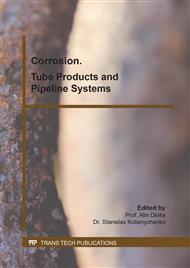[1]
D.V. Fedin, A.F. Barhatov, A.A. Vazim, Comparative analysis of economical effectiveness of methods of increase the field pipelines operating reliability, Bulletin of Tomsk Polytechnic Univeristy. 320(6) (2012) 32-35.
Google Scholar
[2]
V.V. Kravtsov, Corrosion and protection of contracture materials: Textbook for high education institutes, Ufa: Publishing House UGNTU, (1999).
Google Scholar
[3]
S.V. Novikov, Problems of protection of welded joints of pipelines with coating and methods of their solution, Exposition Oil-Gas, 3/N (64) (2008) 91-94.
Google Scholar
[4]
V. Kumar, G. Singh, M.Z.K. Yusufzai, Effects of process parameters of gas metal arc welding on dilution in cladding of stainless steel on mild steel, MIT international Journal of Mechanical Engineering, 2(2) (2012) 127-131.
Google Scholar
[5]
N.N. Rykalin, Calculations of thermal processes in welding, Textbook, Moscow, Machgiz, (1951).
Google Scholar
[6]
A.V. Konovalov, A.S. Kurkin, A.S. Kurkin, E.S. Makarov, V.M. Nerovnyy, B.F. Yakushin, Theory of welding processes, Textbook for high education institutes, Moscow: MSTU named after N.E. Bauman, (2007).
Google Scholar
[7]
Zina Dhib, Noamen Guermazi, Monique Gaspérini, Nader Haddar, Cladding of low-carbon steel to austenitic stainless steel by hot-roll bonding: Microstructure and mechanical properties before and after welding (2016).
DOI: 10.1016/j.msea.2015.12.088
Google Scholar
[8]
S. Aguilar, R. Tabares, C. Serna: Microstructural transformations of dissimilar austenite-ferrite stainless steels welded joints. J. Mater. Phys. Chem. 1, 65 (2013).
Google Scholar
[9]
J.R. Davis, Stainless steel cladding and weld overlays, ASM Specialty Handbook: Stainless Steels, 06398G (1994) 107-119.
Google Scholar
[10]
Sugehis Liscano, Linda Gil, Mariana H. Staia. Effect of sealing treatment on the corrosion resistance of thermal-sprayed ceramic coatings, Surface & Coatings Technology, 188-189 (2004) 135-139.
DOI: 10.1016/j.surfcoat.2004.08.009
Google Scholar
[11]
Sugehis Liscano, Linda Gil, Mariana H. Staia. Correlation between microstructural characteristics and the abrasion wear resistance of sealed thermal-sprayed coatings, Surface & Coatings Technology, 200 (2005) 1310-1314.
DOI: 10.1016/j.surfcoat.2005.07.092
Google Scholar
[12]
N. Tiyasri and B. Poopat, Welding Procedure Development for Welding of High Strength Carbon Steel Cladded with Austenitic Stainless Steel 316L by Using Overmatching Filler Metal, Key Engineering Materials, 545 (2013) 182-187.
DOI: 10.4028/www.scientific.net/kem.545.182
Google Scholar
[13]
A.R. Meyster, I.A. Rukavishnikov, Peculiarities of surfacing of austenite steel in protection gases, Youth and Science: Materials of VIth Russian science technical conference of students, PhD students and post-docs, Krasnoyarsk: Siberian Federal Univerisity, (2011).
Google Scholar
[14]
M. Sireesha, S.K. Albert, V. Shankar, S. Sundaresan, A comparative evaluation of welding consumables for dissimilar welds between 316LN austenitic stainless steel and Alloy 800, Journal of Nuclear Materials, 279 (2000) 65-76.
DOI: 10.1016/s0022-3115(99)00275-5
Google Scholar
[15]
Sindo Kou, Welding Metallurgy, 2nd Edition. 2003 John Wiley & Sons, Inc. 9. J.N. Dupont, Solidification of an Alloy 625 Weld Overlay. Metallurgical and Materials transactions, 27A, (1996).
Google Scholar
[16]
R. Baboian and G. Haynes, Corrosion of Clad Stainless Steels, Proc. ELSI VII (Cambridge, Metals, Corrosion, Vol 13, ASM Handbook, United Kingdom), Sept 1987 ASM Intemational, (1987) 887-890.
Google Scholar
[17]
N. Murugan, R.S. Parmar, Effects of MIG process parameters on the geometry of the bead in the automatic surfacing of stainless steel, Journal of Materials Processing Technology, 41 (1994) 381-398.
DOI: 10.1016/0924-0136(94)90003-5
Google Scholar
[18]
P.K. Ghosh, P.C. Gupta, V.K. Goyal, Stainless steel cladding of structural steel plates using the pulsed current GMAW process, Welding Journal, Welding Research Supplements, (1998) 307-314.
Google Scholar
[19]
S.N. Polyanskii, and V.S. Kolnogorov, Cladded steel for the oil and gas industries, Chemical and Petroleum Engineering, 3 (2002) 703-707.
Google Scholar
[20]
J.R. ReGina, J.N. Dupont, A.R. Marder, The Effect of Chromium on the Weldability and Microstructure of Fe-Cr-Al Weld Cladding, Welding Journal, 86 (2007) 170-178.
Google Scholar
[21]
W. Lucas, Arc surfacing and cladding processes to enhance performance in service and to repair worn components. Welding and Metal Fabrication, 62 (1994) 55-60.
Google Scholar



